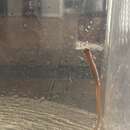Description
(
Inglês
)
fornecido por AmphibiaWeb articles
Eurycea chamberlaini was previously thought to have been a color morph variant of Eurycea quadridigitata (Holbrook, 1842; Bishop, 1943; Dunn, 1926) from North and South Carolina. Recent work (Harrison, III and Guttman, 2003) shows that the morphs are in fact two allopatric species based on allozyme, osteological, behavioral, morphometric, and larval evidence. Bishop (1943) first noted the two morphs, one with a completely yellow venter lacking dark markings (what he referred to as “the light form”) and the other with a uniformly pigmented venter with small dark brown flecks (his “dark form”). Dunn’s (1926) description of E. quadridigitata is a composite of characters from both the “dark” and “light” morphs. Mittleman’s (1947) study on geographic variation in E. quadridigitata concluded no morphological differences across the range (especially in coloration/pattern). Being a hemidactyliine plethodontid, E. chamberlaini is most closely related to E. quadridigitata with which it used to be synonymous. E. chamberlaini is, on average, slightly smaller in SVL than E. quadridigitata (25 mm compared to 28 mm, respectively). E. chamberlaini possesses relatively longer limbs with a mean of 4.2 intercostal folds between adpressed limbs as opposed to a mean of 5.5 in E. quadridigitata. It also averages slightly less prevomerine teeth with a mean of 10 in comparison to the mean of 11.8 of E. quadridigitata. In E. chamberlaini, the processes of the posterolateral frontal are more strongly developed and typically triangular or nearly triangular in shape while they tend to be short and rounded in E. quadridigitata. Both species have 4 digits on hands and feet. The prevomerine tooth series of E. chamberlaini is not sharply arched and the vomer lacks a posterolateral bony shelf. E. chamberlaini usually has 16 costal grooves and 17 trunk vertebrae. 74% of E. chamberlaini larvae have symmetrically or asymmetrically paired dorsal spots. Hatchling E. chamberlaini measure an average of 6.3 mm relative to 6.8 mm in the other. Coloration in this species is bronzy-buff or brownish-buff. Darker markings are present on the dorsum, few or numerous flecks and a mid-dorsal line or irregular row of dots present. Deep layer of guanophores give a bronzy coloration to the dorsum. Dorsum of tail is yellowish or a light bronzy-buff with an orange tinge.
- Harrison, J. R., III, and Guttman, S.I. (2003). ''A new species of Eurycea (Caudata: Plethodontidae) from North and South Carolina.'' Southeastern Naturalist, 2(2), 159-178.
- Holbrook, J. E. (1842). North American Herpetology. J. Dobson and Son, Philadelphia, PA.
- Mittleman, M. B. (1947). ''American Caudata. I. Geographic variation in Manculus quadridigitatus.'' Herpetologica, 3(6), 209-224.
Distribution and Habitat
(
Inglês
)
fornecido por AmphibiaWeb articles
Currently known from the Piedmont in both North and South Carolina, the upper Coastal Plain in South Carolina, and portions of the central Coastal Plain in North Carolina.
Life History, Abundance, Activity, and Special Behaviors
(
Inglês
)
fornecido por AmphibiaWeb articles
Males averaged slightly larger relative head lengths, head width and tail length. Females averaged slightly more prevomerine teeth and a slightly greater average relative limb length; these differences were not statistically significant. E. chamberlaini has an average of 45.2 mm in diameter ova based from clutches of 18 gravid females (on average larger than E. quadridigitata at 39.8).

